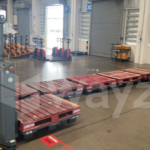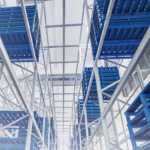In today’s fast-paced world, businesses across industries are constantly seeking ways to streamline operations, boost efficiency, and optimise workflow. One area where innovation is rapidly transforming material handling is through the rise of automated conveyor systems. These intelligent machines are not just moving belts; they are revolutionising the way materials are transported, sorted, and tracked, delivering unparalleled advantages for businesses of all sizes.
From Manual Labor to Intelligent Machines
Traditional conveyor systems, while functional, rely heavily on human oversight and intervention. This can lead to inefficiencies, human error, and limitations in adaptability. Automated conveyor systems, however, rewrite the rules. Leveraging cutting-edge technologies like artificial intelligence (AI), machine learning, and advanced sensors, these intelligent machines operate independently, managing material flow with remarkable precision and speed.
RELATED: Automated Conveyor Systems: Efficient Product Flow and Sorting for Increased Throughput and Capacity
The Powerhouse of Automation
Several key technologies power the impressive capabilities of automated conveyor systems.
- AI and Machine Learning
The brains of the operation, AI algorithms analyse real-time data from sensors to dynamically plan and execute transport routes, optimising for speed and efficiency. This intelligent routing minimises stoppages and adapts to changes in production or workflow. - Sensor Network
A constant flow of data feeds the decision-making process. Optical, pressure, and barcode scanners provide the system with crucial information about package dimensions, weight, destination, and even potential obstructions. This real-time awareness allows for precise sorting, diversion, and tracking. - Actuators
The muscles of the system, actuators like servo motors and pneumatic cylinders translate the commands from the central controller into physical movement. They control belts, diverters, and other mechanisms, ensuring smooth and accurate material movement. - Programmable Logic Controllers (PLCs)
The central nervous system, PLCs analyse sensor data, interpret AI commands, and issue instructions to actuators. They orchestrate the entire operation, ensuring everything runs smoothly and efficiently.
Benefits Beyond Imagination
The advantages of adopting automated conveyor systems are numerous and undeniable.
- Surging Efficiency
By eliminating manual intervention and optimising routes through AI, automated systems significantly reduce bottlenecks and speed up material flow. This translates to increased throughput, faster production cycles, and improved on-time delivery. - Cost Optimisation
Lower staffing requirements due to reduced reliance on human operators translate to significant cost savings. Additionally, efficient material handling and optimised routes minimise energy consumption, further reducing operational expenses. - Accuracy Unmatched
Automated systems rely on precise sensors and intelligent algorithms, virtually eliminating human error in sorting and routing. This leads to fewer misplaced packages, reduced damage, and improved product quality. - Enhanced Safety
With humans removed from the immediate vicinity of moving conveyors, the risk of workplace accidents diminishes dramatically. Safety sensors further protect personnel and equipment by stopping operations in case of obstructions. - Real-Time Transparency
Comprehensive data collection and tracking provide valuable insights into material location, inventory levels, and overall system performance. This real-time visibility empowers better decision-making and facilitates continuous improvement. - Scalability and Flexibility
Unlike their rigid predecessors, automated systems are inherently flexible. Conveyor lines and diverters can be readily added, removed, or reconfigured to adapt to changing production volumes, product types, or facility layouts.
Applications Spanning Industries
The versatility of automated conveyor systems makes them invaluable across various industries.
- Warehousing and Distribution
From streamlined put away and sorting to rapid order fulfillment, automated systems transform warehouse operations, boosting productivity and improving customer satisfaction. - Manufacturing
Automated material handling within production lines ensures seamless delivery of parts and work-in-progress, optimising assembly processes and enhancing product quality. - Airports
Sorting and routing of checked luggage through security and onto loading zones becomes swift and efficient, improving passenger experience and airport operations. - Retail
From automated inventory sorting in large stores to moving goods from stockrooms to sales floors, these systems boost operational efficiency and product availability. - Postal Services
Automated mail and package sorting and routing significantly accelerate delivery times, ensuring efficient postal operations.
A Glimpse into the Future
As AI, sensor technology, and actuator capabilities continue to evolve, the potential of automated conveyor systems expands even further. We can expect:
- Hyper-Intelligent Systems
Deep learning algorithms will further refine route optimisation and decision-making, anticipating changes and proactively adjusting operations. - Predictive Maintenance
Real-time data analysis will enable advanced fault prediction and prevent downtime, ensuring peak system performance. - Human-Machine Collaboration
Automation will not replace human workers but rather work alongside them, providing valuable assistance and improving overall safety and productivity.
Step into the future with SmartlogitecX, a WayZim Technologies venture, reshaping Warehouse Automation in Australia and New Zealand. Our mission is to provide you with advanced, efficient warehouse solutions that are a step ahead. SmartlogitecX combines global tech insights with local market expertise. Ready to upgrade your logistics? Our sales team is on hand to craft your ideal automation strategy.
Read more: The Rise of Automated Conveyor Systems: Revolutionising Efficiency and Productivity.



